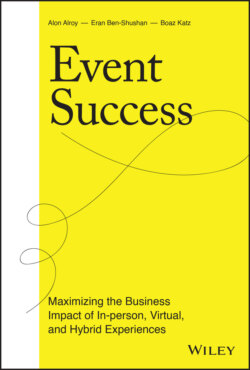Читать книгу Event Success - Alon Alroy - Страница 9
An Industry Ripe for Disruption
ОглавлениеOn the surface it appeared that the events industry had been growing steadily; budgets were increasing, attendee numbers were growing, and event organizers were being given license to curate incredible experiences for their audiences.
Apple, IBM, Microsoft, Cisco, Google, Salesforce, Amazon—nearly every major technology company produced a major flagship event for tens of thousands of attendees. Meanwhile, staging a flagship conference became a mark of success for thousands of emerging technology companies. And all this is to say nothing about how nonprofits, associations, media companies, and financial institutions leverage events to drive their own business goals.
A 2018 report published by the Events Industry Council reported that, accounting for indirect and induced impacts, events supported a global economic impact of $2.5 trillion of business sales, 26 million jobs, and $1.5 trillion of GDP. According to a 2021 report from Allide Marketing, the events industry was valued at $1,135.4 billion in 2019 and is expected to reach $1,552.9 billion by 2028, registering a compound annual growth rate of 11.2 percent from 2021 to 2028.2
Below the surface, however, Marco Giberti says events were simultaneously experiencing a gradual decline—so gradual that it largely went unnoticed. In recent years, the Net Promoter Score (NPS)—a metric used to measure customer loyalty—was flat at best. It was not a dramatic trend by any means, but it suggested something worth considering: both exhibitors and attendees weren't excited about the events they were going to. In other words, the experience of events was missing the mark.
What prevented many decision makers from seeing this decline involved the reliance on business models and benchmarks. The real estate model, for example, more often than not dictated the financial structure of some events. These events were often approached as a simple math equation: X square feet of exhibition space, divided by Y exhibitors, times $Z per square foot in the receivable column; marketing budgets, speaker fees, venue rental, catering costs, and other expenses in the payable column. So long as the revenue generated exceeded expenses, the event was in the black and was considered a success. If certain exhibitors or attendees had a negative experience, it didn't really matter as long as space (and registrations) sold out the following year.
In cases where profitability from exhibitors, sponsors, and registration sales was not the desired outcome (as for many corporate events), event organizers lacked a common set of benchmarks for evaluating how an event contributed to key business outcomes.
Proving event success, or return on events (ROE) as we call it, has long been an incomplete science with event organizers measuring the performance of events on a simple basis—if at all—without a clear understanding of the impact an event has on business outcomes. There was always a sense that things were working as intended, even if “how” or “why” couldn't be precisely measured or explained. The lack of quality metrics to measure vital benchmarks like attendee experience, exhibitor and attendee return on investment, the overall quality of the experience, and so on, created a blind spot for the industry, and in that blind spot complacence was growing.
Unlike most industries at the turn of the millennium, live events had no external forces pressuring them to evolve, no new source of disruption, no real risk of being left behind in the digital era. The only risk was innovating too much too quickly, and inadvertently putting a wrench in an otherwise well-oiled machine.
